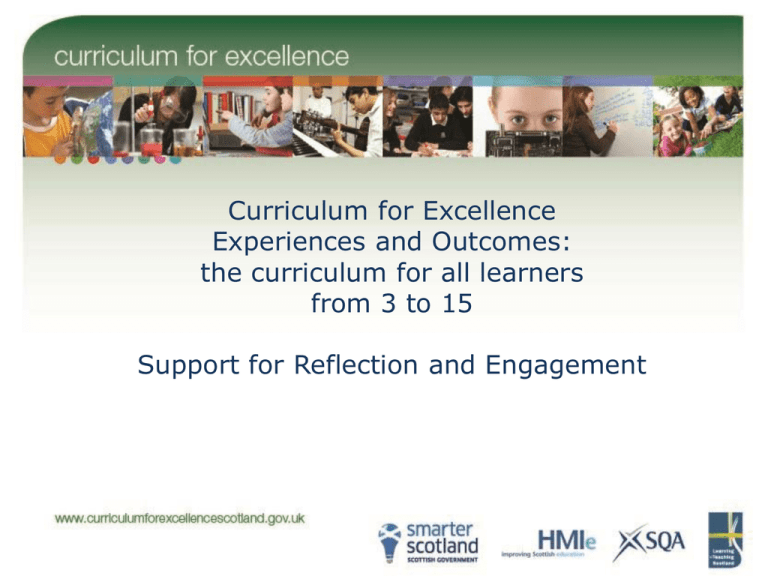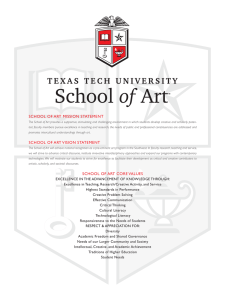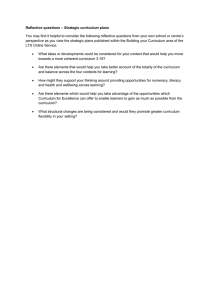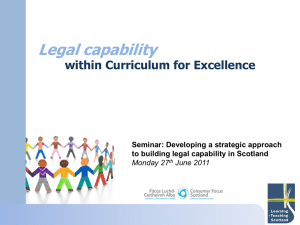Curriculum for Excellence Experiences and Outcomes: the curriculum for all learners
advertisement

Curriculum for Excellence Experiences and Outcomes: the curriculum for all learners from 3 to 15 Support for Reflection and Engagement Overview of Curriculum for Excellence Why does Scotland need Curriculum for Excellence? What is Curriculum for Excellence? How did we reach this point? Next steps? Look across and within curriculum areas Overview of Curriculum for Excellence Why does Scotland need Curriculum for Excellence? What is Curriculum for Excellence? How did we reach this point? Next steps? Why does Scotland need Curriculum for Excellence? Future economy and society: each individual needs the skills and attributes for life, work and learning To ensure the highest standards of attainment and achievement Overview of Curriculum for Excellence Why does Scotland need Curriculum for Excellence? What is Curriculum for Excellence? How did we reach this point? Next steps? Look across and within curriculum areas Entitlements • A coherent curriculum from 3 to 18 • A broad general education from age 3 to the end of S3 or equivalent • A senior phase: opportunities for qualifications and other planned opportunities to develop the four capacities • Learning through the experiences and outcomes across all curriculum areas - Breadth achieved through learning across all the experiences and outcomes in the eight curriculum areas up to the third curriculum level - Most learners will progress towards fourth level in chosen areas at appropriate points during S1 to S3 • Opportunities to develop skills for learning, skills for life and skills for work, literacy, numeracy and health and wellbeing • The best personal support to allow high levels of achievement • Opportunities and support to move into positive and sustained destinations post school The curriculum: all that we plan for children and young people’s learning Values: wisdom, justice, compassion, integrity Effective teaching and active, sustained learning Experiences and outcomes from early to fourth levels in eight curriculum areas Personal support for learning through choices and changes into positive and sustained destinations Entitlements Principles: challenge and enjoyment breadth, progression, depth personalisation and choice coherence, relevance Alignment of assessment, qualifications self-evaluation and accountability, professional development with purposes The curriculum framework: what are the experiences and outcomes for? •They describe national expectations for learning from the early years to the end of S3 (age 3-15). •Together, they embody the attributes and capabilities of the four capacities. •They apply to the totality of experiences which are planned for during a child’s education. •All the experiences and outcomes to the third level and those selected for study at the fourth make up the broad general education to which all children are entitled. How is the guidance structured? The curriculum areas Health and wellbeing across learning Expressive arts Religious and moral education Religious education in Roman Catholic schools Literacy across learning Health and wellbeing Sciences Languages: Literacy and English Literacy and Gàidhlig Modern languages Gaelic (learners) Classical languages Social studies Numeracy across learning Mathematics Technologies What does the guidance include? •Principles and practice section for each curriculum area •Experiences and outcomes for each curriculum area to the third level and those selected for study at the fourth •The broad general education to which all children are entitled from pre-school to S3* The exceptions to this statement are where specific sets of experiences and outcomes are specialised: * Gàidhlig, Gaelic (learners) and classical languages and religious education in Roman Catholic schools. How are the experiences and outcomes structured? •Principles and practice sections: essential information •Introductory statements •Presented across early, first, second, third and fourth levels to indicate progression •Organised into lines of development •Some explanations How can you see progression in the structure of the curriculum framework? What do the ‘codes’ mean? LIT 1-01a Curriculum area code Level code Line of development code Code denoting number of outcomes within line of development at that level LIT – literacy The codes are purely for ease of reference The experiences and outcomes: how did we move from the drafts to the published versions? 1475 questionnaires 937 from groups 241 trialling reports University of Glasgow analysis 20 focus groups 2012 other submissions Plans to address issues raised: edit - explain - exemplify - CPD Further consultation with teachers and others Published version What happened in response to feedback? •Editing and sometimes restructuring of the sets of experiences and outcomes •Provision of further explanations where needed •Plans for exemplification of how the experiences and outcomes can work in practice – this will be published over the coming months •Specific technical and other points addressed Next steps? Teachers can usefully: •look across the entire set to see where their contributions will be •understand their responsibilities within health and wellbeing; literacy; numeracy •familiarise themselves with the framework which relates to a particular stage/subject. Now find out about a particular curriculum area.


